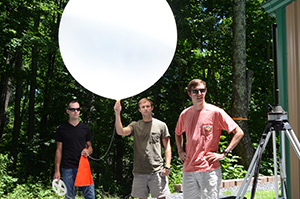Sep 4 2013
Professor Jim Sherman enjoys the area’s mesmerizing blue skies as much as anyone else. But it’s the particles known as aerosols found in the atmosphere that intrigue him the most.
 From left, Ian Krintz, Ben Madison and Craig Stewart prepare a weather balloon for launch. The balloon carries monitoring equipment called a radiosonde that measures vertical profiles of temperature, humidity and winds up to approximately 75,000 feet in the atmosphere and transmits the data to a receiver. The weather data complements long-term aerosol measurements made at Appalachian State University’s AppalAIR research facility.
From left, Ian Krintz, Ben Madison and Craig Stewart prepare a weather balloon for launch. The balloon carries monitoring equipment called a radiosonde that measures vertical profiles of temperature, humidity and winds up to approximately 75,000 feet in the atmosphere and transmits the data to a receiver. The weather data complements long-term aerosol measurements made at Appalachian State University’s AppalAIR research facility.
Since early summer, Sherman, who teaches in Appalachian State University’s Department of Physics and Astronomy, Department of Chemistry research scientist Yong Zhou and a team of students have launched nearly 75 weather balloons to provide information that complements the aerosol measurements taken at the university’s AppalAIR research facility and improves the ability to quantify the amount of reduced sunlight due to aerosols.
Sherman, is studying aerosol effects on regional weather and climate and how these effects are in turn impacted by changing weather and decreasing pollution levels in much of the U.S. His research group uses a laser radar (lidar) to measure how aerosols and clouds vary vertically in the troposphere, the lowest 10 km of the atmosphere.
Aerosols are observed as haze, dust and smoke. In addition to their effects on regional air quality, they directly modify the amount of sunlight transmitted by the atmosphere by reflecting and absorbing the sun’s energy. They also indirectly modify sunlight by altering cloud reflectivity, lifetimes and potential for precipitation.
“The aerosol levels and effects depend a lot on local and regional meteorology,” Sherman explained. “This summer has been somewhat anomalous in terms of heavy precipitation and high humidity. It seems that aerosol properties and amounts depend on the regional weather at least as much as on their source region.”
These effects represent the largest uncertainty in climate models to predict future temperatures in response to the expected changes in carbon dioxide levels, Sherman said. The southeastern U.S. is one of only a few regions in the world not to have warmed during this period and several studies implicate aerosols for at least part of this lack of warming.
The weather balloons launched by Sherman’s research assistants carry a small payload called a radiosonde, which consists of temperature, pressure and humidity sensors and a microwave transmitter. By linking to satellites, wind information is also obtained. The meteorological profiles extend up to approximately 75,000 feet, at which the balloon bursts and a small parachute attached to the radiosonde opens. Some data is still acquired during the descent.
Sherman and Zhou also monitor lower tropospheric aerosol properties, using air drawn from a 34-meter tower into several instruments at AppalAIR as part of the worldwide NOAA Global Monitoring Division aerosol network. A sun- and sky-tracking radiometer and related instruments on top of the former Broyhill Inn monitor still other aerosol properties and are performed as part of the NASA Aerosol Robotic Network (AERONET).
AppalAIR is home to the only co-located NOAA-ESRL and NASA AERONET monitoring sites in the eastern U.S. The combined instrumentation and aerosol chemistry measurements conducted by Zhou represents the second-largest continuous aerosol monitoring effort in the U.S. The country’s largest site is a U.S. Department of Energy facility in Oklahoma.
“Most of the aerosols we get in this part of the country in summer are produced by tree emissions of organic gases that react with gaseous pollutants such as sulfur dioxide and nitrogen dioxide. They undergo some chemical processes and form the aerosols or haze that basically dominates what we see,” Sherman continued.
“Those tree emissions depend largely on temperature, humidity and sunlight and don’t have nearly as much influence in non-summer months. That’s why you may notice the sky is really clear in winter and a dull greyish blue in summer. We go from some of the cleanest air in the world to levels close to Beijing, China, on a few summer days each year,” he said.